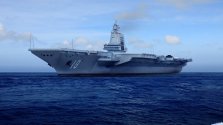Well, i won't go to claim I am sure - but IMHO a more reasonable proportion between surface combatants and even not ideal carriers would've been beneficial. Something along 7-8 fleet combatants(i.e. 052d/055 destroyers) per carrier. Which is actually still ship-rich, the US has way less per escorted hull.
China has shipbuilding pull that allowed that to happen - and, again IMHO, getting to a 4-carrier fleet ca. 2023-24 (+2 additional 001) and a 6-carrier fleet ca. 2026-27(+1 additional 003) would've been more optimal for the currently available number of surface combatants, carrier-capable planes/pilot classes and SSNs.
Add the second, nuclear part on top of that (with two hot&experienced carrier shipyards) and by 2035 we're at local ~parity with the entirety of the USN in Eastpac(or realistically deployable USN+its loyal allies). Quite a tasty result, am I wrong?
And this can't be explained by "no money printer dear", at least not completely. Carriers are expensive as f when taken as package deals.
When PLANAF already pays for its current naval aviation revamp - a large part of that money is already paid; it's the cost of carrier hulls now. And by themselves, even true fleet carriers cost in the order of a few destroyers each (more reserved "medium" carriers cost in order of around 2-2,5 contemporary heavy frigates).
Not a bad deal.
It isn't only about the procurement cost of the carriers but also about the ongoing operational costs and personnel costs.
I agree with your "optimal ratio of carrier to destroyer" but there are also optimal ratios of SSNs, modern land based fighters and bombers and tankers and missiles which have yet to be attained.
This is what I mean by opportunity cost, in terms of what should come first in terms of procurement.
My feeling is that beyond an additional one carrier (or maybe two at most) entering operational capability in the 2025-2035 period, the additional money is better spent in other procurements.

